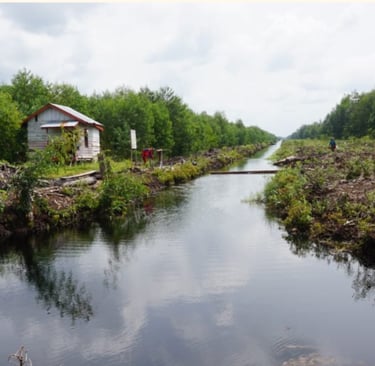Restoring Hope: Agroforestry Practices in Sumatra's Peatlands
HISTORY AND HERITAGE
By Lakeisha Drusillia Wijaya
4/29/20252 min read


Source: https://pantaugambut.id/kabar/potensi-konflik-berkepanjangan-di-lahan-gambut-desa-lebung-itam
The Earth is getting older, and this reality concerns not only how long will the earth survive, but also increasing scarcity in the use of its resources. Land and soil for agriculture are among the resources that are rapidly decreasing due to its non-renewable nature, which has been converted for factories and other types of development. Unfortunately, land-use depletes the natural environment, leaving peatlands as one of the few options for agroforestry practices.
Agroforestry is a land management system that integrates tree or woody plants, agricultural crops, and/or livestock in one area. This system increases land productivity sustainably and provides economic benefits to local communities. In addition, agroforestry also supports peatland restoration and enhances biodiversity.
Peatland management has changed over time. These lands are generally formed in swampy areas that are always flooded and located between two rivers. In the beginning, peatlands were sparsely populated areas with settlements directly connected to the river. As long as the forest that covered the peatland was relatively intact and had not been heavily utilized for settlement or logging, the land tended to remain in its natural state.
In contrast to large-scale peatland conversion schemes for agriculture and plantations, small-scale farmer practices with limited modifications to drainage patterns in Sumatra have long been able to simply overcome environmental challenges to meet livelihood needs, maintaining the hydrological balance of peat, without destroying it. Agroforestry on peatlands can be developed as a combination of various strategic commodities.
Specifically, in Ogan Komering Ilir Regency, South Sumatra, communities in Lebung Itam and Penanggoan Duren Villages have developed rubber agroforestry on peatlands. They try to diversify by planting rubber alongside economically valuable plants such as durian, petai, langsat, betel nut, avocado. This system maintains soil structure and moisture so it protects peatlands from fire or degrading sooner.
However, many farmers faced significant challenges to practice agroforestry including inferior rubber seeds or fertilizers, and improper tapping techniques. Therefore, through a training program by CIFOR-ICRAF and support from the Peat-IMPACTS Indonesia project, the local community was taught to select superior rubber clones (such as PB 260 and GT1), environmentally friendly fertilization methods, and efficient tapping practices.
Furthermore, this program also emphasizes the importance of using organic fertilizers including compost as much as at least 2 kg per planting hole, which has proven effective in supporting rubber growth on peatlands. In addition, farmers are taught to independently graft seedlings as a long-term effort to create a supply of superior seeds that are resistant to disease and have high yields.
There is still a lot of homework to be done to ensure that peatlands are well maintained. Unwise actions will worsen the condition of peatlands, especially in Indonesia. Let us support sustainability in agroforestry so that we can continue to support our lives today, tomorrow, and beyond.
Citations
Armanto, Ardi Nur. “Memahami Peluang Agroforestri Berbasis Paludikultur Di Lahan Gambut Sebagai Strategi Restorasi – LCDI,” June 30, 2022. https://lcdi-indonesia.id/2022/06/30/memahami-peluang-agroforestri-berbasis-paludikultur-di-lahan-gambut-sebagai-strategi-restorasi/.
Aprianti, Safira Eka. “Agroforestri-Paludikultur: Masa Depan Lahan Gambut Dan Ketahanan Pangan.” Kumparan, July 10, 2024. https://m.kumparan.com/safira-1720332971114348804/agroforestri-paludikultur-masa-depan-lahan-gambut-dan-ketahanan-pangan-236IfIkqHYr.
CIFOR-ICRAF. “Pengetahuan | CIFOR-ICRAF,” March 6, 2025. http://www.cifor-icraf.org/id/pengetahuan/publikasi/23353/.
